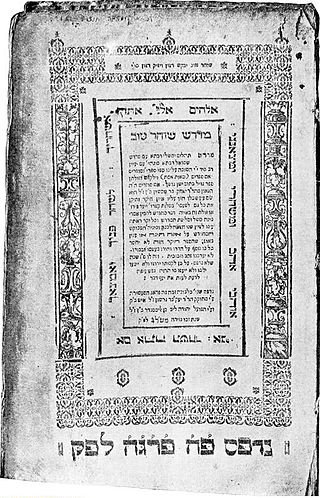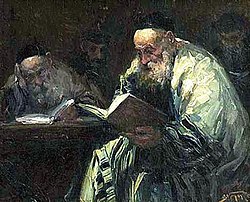
Midrash is expansive Jewish Biblical exegesis using a rabbinic mode of interpretation prominent in the Talmud. The word itself means "textual interpretation", "study", or "exegesis", derived from the root verb darash (דָּרַשׁ), which means "resort to, seek, seek with care, enquire, require", forms of which appear frequently in the Hebrew Bible.

The Mekhilta of Rabbi Ishmael is midrash halakha to the Book of Exodus. The Aramaic title Mekhilta corresponds to the Mishnaic Hebrew term מדה middah "measure," "rule", and is used to denote a compilation of exegesis.
Tobiah ben Eliezer was a Talmudist and poet of the 11th century, author of Lekach Tov or Pesikta Zutarta, a midrashic commentary on the Pentateuch and the Five Megillot.

Sifre refers to either of two works of Midrash halakha, or classical Jewish legal biblical exegesis, based on the biblical books of Numbers and Deuteronomy.

Midrash Tanhuma is the name given to three different collections of Torah aggadot; two are extant, while the third is known only through citations. These midrashim, although bearing the name of Tanhuma bar Abba, must not be regarded as having been written or edited by him. They were so named merely because they consist partly of homilies originating with him and partly of homilies by aggadic teachers who followed the style of R. Tanḥuma. It is possible that R. Tanḥuma himself preserved his homilies, and that his collection was used by the editors of the midrash. The three collections were edited at different times; they will, therefore, be treated in chronological order. According to Samuel Berman's most recent research and translation on Midrash-Tanhuma, the "earliest manuscript of this text was compiled in late 8th or 9th century".

Exodus Rabbah is the midrash to Exodus.

Pesikta de-Rav Kahana is a collection of aggadic midrash which exists in two editions, those of Salomon Buber and Bernard Mandelbaum (1962). It is cited by Nathan ben Jehiel and Rashi.

Midrash Tehillim, also known as Midrash Shocher Tov or the Midrash to Psalms, is an aggadic midrash to the Psalms.

Midrash Abkir is one of the smaller midrashim, the extant remains of which consist of more than 50 excerpts contained in the Yalkut Shimoni and a number of citations in other works. It dealt, according to all accessible evidence, only with the first two books of the Pentateuch.

Midrash Proverbs is the aggadic midrash to the Book of Proverbs.

The Mekhilta of Rabbi Shimon ben Yochai is midrash halakha on Book of Exodus from the school of Rabbi Akiva attributed to Shimon bar Yochai. No midrash of this name is mentioned in Talmudic literature, but Nachmanides (d.1270) refers to one which he calls either Mekhilta de-Rabbi Shimon ben Yochai, Mekhilta Achǝrita de-Rabbi Shimon, or simply Mekhilta Acheret. Todros ben Joseph Abulafia (d.1285) also refers to Mekhilta de-Rabbi Shimon ben Yochai.

The Midrash on Lamentations is a midrashic commentary to the Book of Lamentations.

Deuteronomy Rabbah is an aggadah or homiletic commentary on the Book of Deuteronomy.

Baraita on the Erection of the Tabernacle is a baraita cited several times by Hai ben Sherira, by Nathan ben Jehiel in the Arukh, as well as in Rashi, Yalkut Shimoni, and Maimonides. Rashi calls it a "Mishnah".

The Baraita of the Forty-nine Rules is a work of rabbinical literature which is no longer in existence except in references by later authorities. It is mentioned or cited by Rashi, the Tosafists, Abraham ibn Ezra, Yalḳut, and Asher ben Jehiel. Rashi on Exodus 26:5, Yalkut Shimoni Genesis 61, calls it "Midrash"; Rashi on Exodus 27:6 calls it "Mishnah".

Midrash Samuel is an aggadic midrash on the books of Samuel.

Esther Rabbah is a midrash to the Book of Esther.

Midrash Veyechulu is one of the smaller midrashim, named after Genesis 2:1. It contained both halakhic and aggadic material, and doubtless covered several books of the Pentateuch; but it now exists only in citations by various authors after the middle of the 12th century.

Yalkut haMachiri is a work of midrash. Its author was Machir ben Abba Mari, but his country and the period in which he lived are not definitively known. Moritz Steinschneider says that Machir lived in Provence; but his date remains a subject of discussion among modern scholars. Strack & Stemberger (1991) say that the work was most probably composed in the late 13th or 14th century.

Midrash Jonah is the aggadic midrash to the Book of Jonah.




















